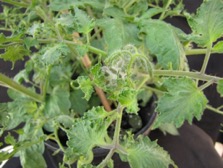What’s new with herbicides?
2020 brings new registrations of use to the vegetable producer. Weed control in vegetables usually requires a careful integration of tillage, herbicides, cultivation and mulches. No single herbicide will control all weeds for the entire season. The following summarizes guidelines for use on crops that extracted from product labels, the final authority. If you have further questions please contact me, or your local agricultural educator.
Pumpkin, Squash & Tomato. Reflex Herbicide (EPA Reg. No. 100-993). (Ohio Section 24 OH0993019AA0619 OH-200002; for use only in Ohio). Pumpkin, squash and tomato varieties may vary in their tolerance to Reflex herbicide. Be certain of crop tolerance before using Reflex on a new variety. Butternut squash is very sensitive to Reflex. Cold and wet soils during pumpkin and squash germination and maturity may result in delayed maturity and/ or yield. Heavy rain shortly after transplanting may also result in delayed maturity and/ or yield. Reflex persists in the soil for a considerable time providing weed control; however, this characteristic also means that several crops may be damaged if grown in close rotations following use of Reflex.
• Direct Seeded Pumpkin, Summer and Winter Squash (32 day PHI). Apply Reflex at ½ – 1 pint/A broadcast preemergence after seeding and before the crop emerges. If rainfall does not occur before crop emergence, an overhead irrigation will activate the herbicide and reduce the potential for crop injury from splashing soil onto crop leaves.
• Transplant Pumpkin, Summer and Winter Squash(32 day PHI). Apply Reflex at ½ – 1 pint/A as a pre-transplant, non-incorporated preemergence broadcast application up to 7 days before transplanting. Minimize further soil disturbance during transplanting or weed control may be compromised, and avoid any practice that may concentrate the herbicide around the transplant plug.
• Transplant Tomato on bare ground (70 day PHI). Apply Reflex at 1 pint/A as a pre-transplant, non-incorporated preemergence broadcast application up to 7 days before transplanting. Minimize further soil disturbance during transplanting or weed control may be compromised, and avoid any practice that may concentrate the herbicide around the transplant plug.
• Transplant Tomato in plastic mulch (70 day PHI). Apply Reflex at 1 pint/A as a pre-transplant, non-incorporated preemergence broadcast application after the final raised bed has been formed but before mulch has been laid. Do not disturb the soil after laying the mulch.
Onion (bulb) & Leeks (60 day PHI). Zidua Herbicide (EPA Supplemental Label, Registration No. 7969-338). Apply postemergence, after seeded onion emergence or after transplanting leeks but before broadleaf weeds have emerged. Zidua does not control emerged weeds. Apply 1.3 to 1.7 ozs/A to onion and leek in medium or fine textured soils. Apply 1.7 ozs/A to onion or leak in muck soils with 20% or more organic matter. Crop-stage should be 2-6 true leaves. Do not apply to coarse textured soils.
Asparagus & Rhubarb. QuinStar 4L Herbicide (EPA Reg’n No. 42750-169). For control of emerged field bindweed and hedge bindweed, apply Quinstar in the fall but before frost to bindweeds that are actively growing. Apply Quinstar at 12.6 ozs/ Acre mixed with crop oil concentrate at 2 pints/ Acre.
Okra (14 day PHI). Caparol 4L (EPA Reg’n No. 100-620). For control of broadleaf weeds apply Caparol 4L preemergence after seeding and before crop emergence at the rate of 3 pints/Acre. Alternatively, apply 1.5 pints/ Acre preemergence and a second directed-postemergence application of Caparol when the okra plants have 7-9 leaves and weeds are 2 inches tall or smaller.
Lettuce. Dual Magnum. (EPA Reg’n No. 100-816 EPA SLN No. OH-190001; for use in Ohio only). For control and suppression of annual grasses, yellow nutsedge and small-seeded broadleaf weeds.
• Leaf lettuce, seeded or transplant (25 day PHI). Apply Dual Magnum at 0.67-1.0 pints/ Acre preemergence to weeds either before crop emergence or transplanting. Alternatively, an over-the-top- or directed- postemergence application of Dual Magnum at 0.67 pints/ Acre can be made before weed emergence. If pre and post applications are used the total amount of Dual Magnum should not exceed 1.33 pints/ Acre per crop.
• Head Lettuce, seeded or transplant (20 day PHI). Apply Dual Magnum at 0.67-1.0 pints/ Acre preemergence to weeds either before crop emergence or transplanting. Alternatively, an over-the-top- or directed- postemergence application of Dual Magnum at 0.67-1.0 pints/ Acre can be made before weed emergence. If pre and post applications are used the total amount of Dual Magnum should not exceed 2.0 pints/ Acre per crop.
The research behind these new uses was paid for in part by the IR-4 Program, the Ohio Vegetable and Small Fruit Research and Development Program (OVSFRDP), and was only possible because we have a great network of OARDC research stations and personnel in key vegetable producing areas of the state. Thanks also to the various pest management supply companies that supported development of their products for use on specialty crops.








